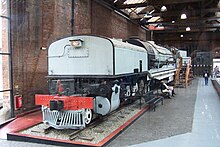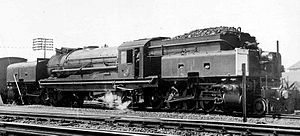SAR class GL
| SAR class GL | |
|---|---|
|
SAR class GL No. 2351 with chimney flap
|
|
| Numbering: | 2350-2357 |
| Number: | 8th |
| Manufacturer: | Beyer-Peacock |
| Year of construction (s): | from 1929 |
| Retirement: | 1972 |
| Type : | (2'D1 ') (1'D2') h4 (Garratt) |
| Gauge : | 1067 mm ( cape track ) |
| Length over coupling: | approx. 27,600 mm |
| Service mass: | 214.5 t |
| Friction mass: | 147.1 t |
| Wheel set mass : | 19 t |
| Starting tractive effort: | 350 kN |
| Driving wheel diameter: | 1219 mm |
| Cylinder diameter: | 558 mm |
| Piston stroke: | 660 mm |
| Boiler overpressure: | 138 N / cm² |
| Grate area: | 6.92 m² |
| Radiant heating surface: | 31.59 m² |
| Tubular heating surface: | 282 m² |
| Superheater area : | 75.1 m² |
| Train brake: | Suction air brake |
The locomotives of the class GL of the South African Railways (SAR) are the largest Garratt steam locomotives that have been ever built for South Africa, and with a tensile force of more than 40 tons of the most appealing steam locomotives in the southern hemisphere.
history
The electrification of the Natal Main Line between Durban and Glencoe was already being considered in 1914, but the idea was discarded because of the outbreak of the First World War . Work only began in 1922 for the section north of Pietermaritzburg , which was in continuous operation in 1926. The 1,450 t coal trains from the pits in Glencoe were hauled by three class 1E locomotives developed by Swiss industry . On the not yet electrified section between Pietermaritzburg and Durban, these trains were pulled by two class 14 2'D1 ' steam locomotives . Since the line was a bottleneck, the SAR decided to bridge the time until the completion of electrification to procure Garratt locomotives, which could take over the trains from the electrically operated section without having to use two locomotives in pre-tensioning operation.


The locomotive planned by SAR's chief engineer AG Watson had to be 50% more powerful than all previously built locomotives for Cape Gauge . Because the boiler diameter, at 2.15 m , was supposed to be more than double the gauge , there were concerns about the stability and running properties of the locomotive. Only two were initially ordered by Beyer-Peacock , which were put into service in October 1929 and extensively tested. On the Cato Ridge – Durban section, the locomotive was able to drive trains with 1500 t to 2000 t, in the opposite direction they pulled 1205 t over the ramp, which has a practically continuous gradient of 15 ‰. Because the running characteristics of the locomotives were also impressive, a further six locomotives were ordered after seven weeks of testing.
Until the electrification work was completed at the end of 1936, the locomotives remained in use on their main line; Then they were used in front of coal trains between Glencoe and Vryheid , where they had to pull trains weighing up to 20 ‰ 1200 t on gradients - more than the power required for the design of the locomotives.
This line was also electrified by 1968, and the GL came to the line between Stanger and Empangeni . However, they were not fully utilized there and were replaced by the smaller Garratts of the GMA / GMAM class . The locomotives were decommissioned in 1972 after a contemplated use on the drainage hill in the Bloemfontein marshalling yard did not materialize.
Two copies (No. 2351 and 2352) have been preserved. No. 2351 was operational until at least the late 1990s and is on display in the Outeniqua Transport Museum in George ; the number 2352 is in the Museum of Science and Industry in Manchester .
technology
The class GL has the wheel arrangement (2'D1 ') (1'D2'), also called double-mountain . It was designed for a minimum radius of 83.8 m and could also negotiate counter curves of 91.4 m radius with a cant of 114 mm without an intermediate straight. For this reason the pivot of the front motor bogie was made spherical to avoid tension in the 27.6 m long locomotive.
The cylinder and drive wheel diameters were taken over from class 14. The motor bogies were designed with bar frames. Two-axle running bogies ensured good cornering. The drive was on the third coupling axis , so that long drive rods could be used that ran downwards at a small angle , which, compared to a drive on the second coupling axis, caused lower vertical forces on the crosshead . The steam boiler with a round stand-up boiler ceiling and fire box water chambers were fired with coal via a stoker . 12.2 t of coal and 31.8 m³ of water could be carried as supplies. The chimneys of the six subsequently delivered locomotives had steam-operated chimney flaps for the journey on the route with many tunnels - a device that was dismantled again when moving to Vryheid.
Web links
Individual evidence
- ↑ a b c Heinie Heydenrych, Bruno Martin: The Natal Main Line story . HSRC Publishers, 1992, ISBN 978-0-7969-1151-3 , pp. 123, 125 .
- ^ AE Durrant: Garratt Locomotives of the World . Springer-Verlag, 2013, ISBN 978-3-0348-6523-4 , pp. 139-141 ( Google Book ).

